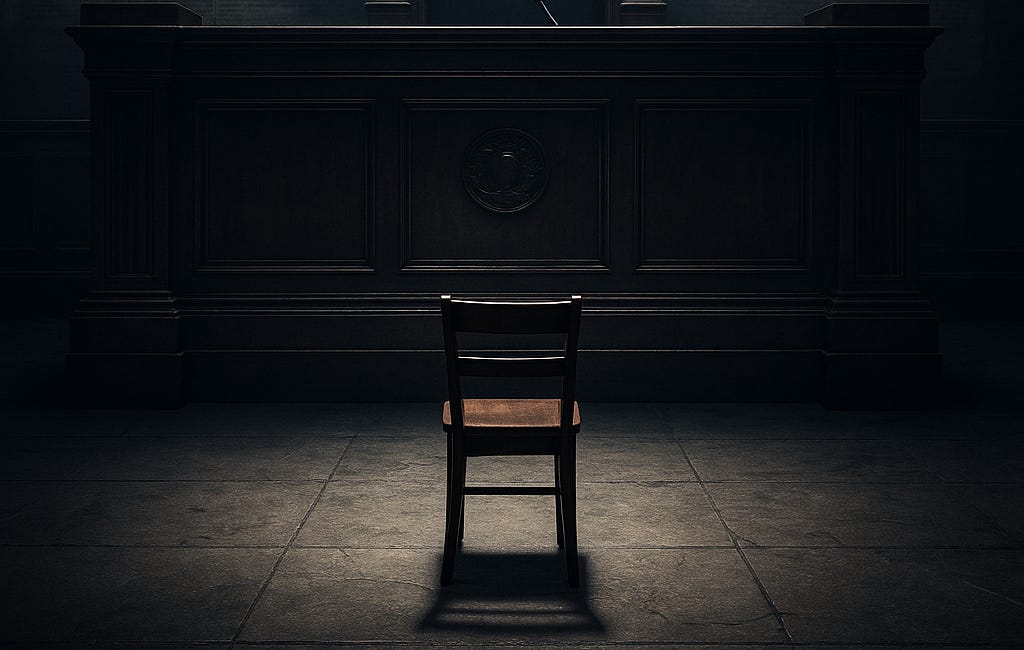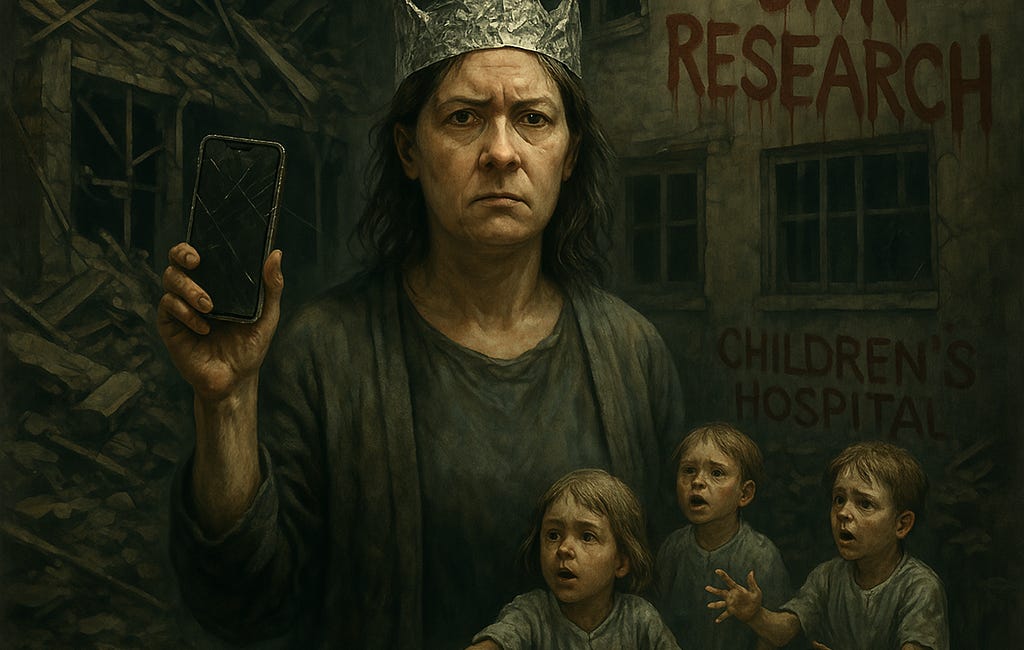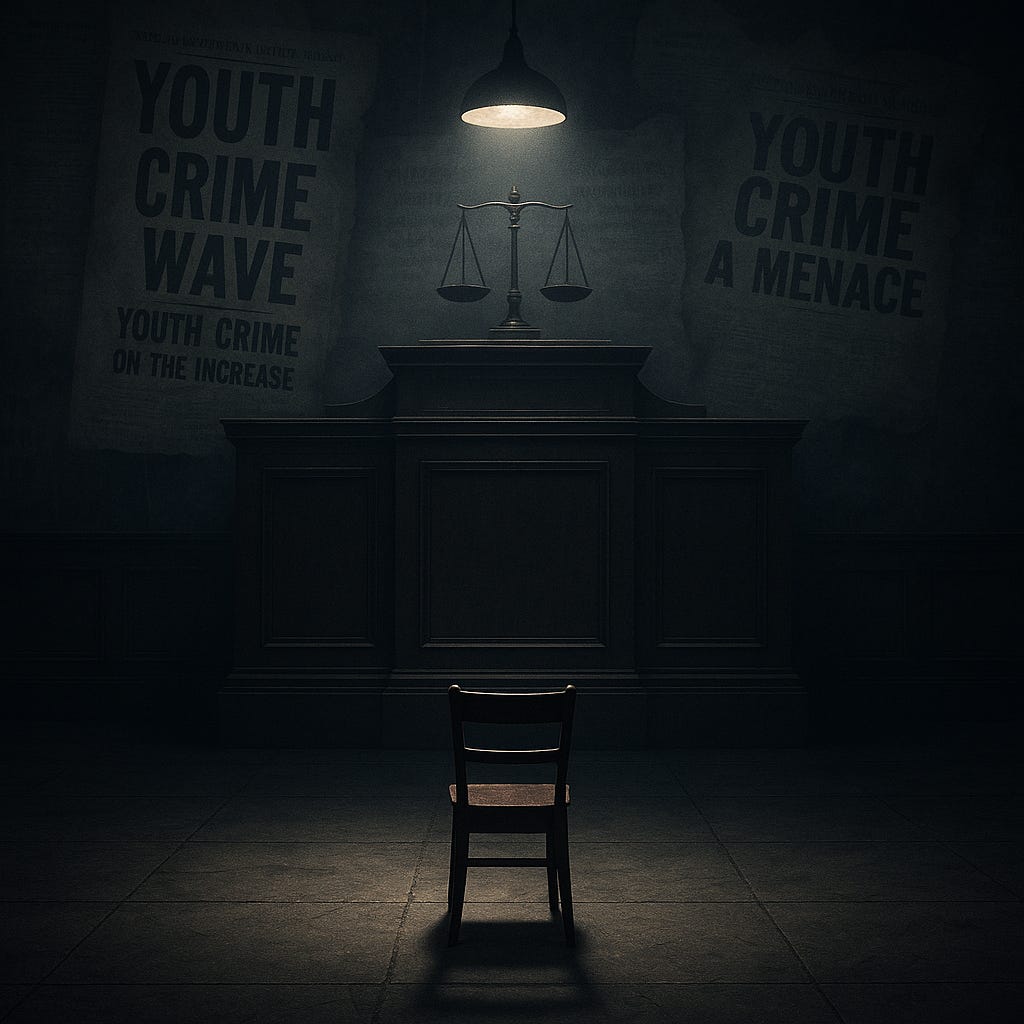Part II: From Super-Predators to Super-Predators-in-Power. How the Age Game Protects Abusers and Feeds Authoritarianism
Summary: Part II maps the direct line from the ’90s “super-predator” lie to today’s D.C. crackdown, showing how lowering age laws doubles as a shield for elite abusers.
Let’s be clear, the “lower the age of criminal responsibility” push is not some random, spontaneous idea floating through the collective subconscious of D.C. law enforcement. It’s a pre-loaded cartridge in a well-worn political weapon, one that’s been test-fired for decades, fine-tuned to deliver maximum fear and minimal actual safety.
And when you track who’s pulling the trigger, you start to see the shadow of another truth: this isn’t just about putting more kids in prison. It’s about rewriting the law so that the very people rewriting it can stand in the clear.
1. The “Super-Predator” Hoax — Anatomy of a Manufactured Crisis
In the mid-1990s, Princeton political scientist John DiIulio made his infamous prediction that America was about to be overrun by “super-predators” a wave of “radically impulsive, brutally remorseless” teens who would commit violent crimes without conscience.
“They are perfectly capable of committing the most heinous acts of physical violence for the most trivial reasons… they are time bombs ticking away.” John DiIulio, 1995.
The prediction was wrong. Dead wrong. But at the time, it was political gold.
Bill Clinton signed the 1994 Crime Bill, which provided states with incentives to enact harsher laws for juveniles.
Joe Biden, then chair of the Senate Judiciary Committee, pushed hard on the “predator” narrative.
State legislatures rushed to lower the age for prosecution as an adult. In some states, kids as young as 13 could now be tried as adults for certain crimes.
The result? Tens of thousands of juveniles, disproportionately Black and Latino, were sentenced as adults through the late ’90s and early 2000s. Many were sent to adult prisons, where the risk of sexual assault was astronomically higher than in juvenile facilities.
By 2001, juvenile crime rates had plummeted, without the apocalypse DiIulio had predicted. He admitted he was wrong. The politicians and prosecutors who rode the panic to power never apologized. The laws stayed on the books.
And here’s the crucial link to today: once those laws existed, they could be tweaked, redirected, and used as precedent to lower other age thresholds, marriage, consent, emancipation, under the same “if they’re old enough to be punished, they’re old enough to…” logic.
2. The Legal Two-Step: Lower Criminal Age, Then Lower Consent Age
If you think I’m reaching, look at the legislative record.
Tennessee, 2022
Bill HB 233 allowed marriage at any age, YES, ANY, until public outrage forced a last-minute rewrite. The bill’s sponsor? State Rep. Tom Leatherwood (R), who defended it as “restoring traditional marriage.” Leatherwood had previously voted for bills lowering the age of criminal prosecution for certain juvenile offenses.
Missouri, 2018
Lawmakers lowered the marriage age from 15 to 16 (with judicial approval) but rejected efforts to raise it to 18. State Rep. Jean Evans (R) claimed raising it further would be “government overreach.” Evans also supported “truth in sentencing” laws for juveniles, making them eligible for adult sentences sooner.
Florida, 2021–2023
A wave of “parental rights” bills weakened child welfare oversight. It expanded parental control over minors’ decisions, including reproductive care and, in proposed amendments, the possibility of marriage under 18 with parental consent. At the same time, Florida lowered the threshold for charging juveniles as adults in certain violent crimes.
Pattern: Use a high-profile youth crime to justify lowering criminal responsibility. Then, in a different legislative session, use the “logic” of that precedent to chip away at protections in other areas.
3. The Epstein Network: Who Benefited From Legal Loopholes?
Jeffrey Epstein didn’t just exploit underage girls; he exploited a patchwork of state laws that made it easier to target and groom them without triggering mandatory felony charges.
Florida: At the time of Epstein’s 2005 arrest, the age of consent was 18, but a “close-in-age” exemption allowed 16- and 17-year-olds to consent to sex with adults under certain circumstances. Florida also had discretionary juvenile transfer laws, giving prosecutors leverage over the peers of victims.
New Mexico: Age of consent: 17. Epstein’s Zorro Ranch was located here, and reports indicate he brought girls across state lines to exploit the difference in age laws.
U.S. Virgin Islands: Where Epstein registered his sex offender status, but also enjoyed lax enforcement and legal gray zones.
The people who protected Epstein, from Alexander Acosta (Trump’s Labor Secretary, who cut the original sweetheart plea deal) to the politicians who fought to keep the “client list” sealed, overwhelmingly belong to the same political ecosystems that push “tough on crime” for kids, but “soft on exposure” for elites.
Lowering the age of adulthood in the criminal code isn’t just a youth-punishment tool. It’s a grooming tool, making it easier to claim “consent” from younger teens and harder for prosecutors to bring statutory charges against adults in power.
4. The D.C. Gambit as Proof of Concept
What’s happening in D.C. right now, with Trump threatening federalization and Pirro calling to lower the age to 14, is a test case. If they can frame a city with declining crime stats as an urban war zone and win a high-profile legal shift, they can export it.
Step back and see the pitch:
Federal override of local governance (a Trump fetish).
High-profile youth case (the “Big Balls” assault) amplified by media allies.
Rhetorical frame: “Enough is enough,” pure super-predator-era language.
Follow-up opportunity: introduce legislation aligning criminal responsibility with other “adult” capacities.
That last point is where the danger lies. Once you have “14 is an adult” for criminal purposes, the leap to “14 is an adult” for marriage or consent, under “parental rights” or “states’ rights” — is far easier to sell.
5. Historical Echo: The Age of Consent Panic of the 1880s–1890s
The first wave of U.S. age-of-consent laws in the late 19th century established most thresholds shockingly low, ranging from 10 to 12 years old in many states. Reformers, led by the Women’s Christian Temperance Union, fought to raise it, often meeting fierce resistance from legislators who claimed it would “criminalize innocent relationships” and “destroy traditional courtship.”
Guess what arguments they used?
“Some girls mature faster than others.”
“It’s unfair to punish young men for consensual behavior.”
“Families should decide, not the state.”
The same refrains echo today in statehouses debating child marriage bans and parental consent laws for minors’ healthcare.
6. The Media’s Role: From Hearst to Fox
Moral panics need megaphones. In the 1890s, it was William Randolph Hearst’s newspapers splashing lurid stories of “girl victims” and “youth gangs.” In the 1990s, it was network TV and local news crime segments. Today, it’s Fox News, OANN, and the hyper-partisan social media ecosystem.
Pirro’s appearance on The Ingraham Angle wasn’t an accident. It was staging. Ingraham’s audience is primed to view urban youth as a threat, distrust local Democratic governance, and embrace federal “law and order” interventions. By the time policy is introduced, the public theater has already done the emotional work.
7. The International Angle: Authoritarian Age Games
Other countries have used the same tactic.
Hungary under Viktor Orbán lowered certain criminal age thresholds while simultaneously pushing laws that restricted sexual education and LGBTQ+ visibility, framing it all as “protecting children” while actually centralizing state control over youth.
Russia lowered the age of criminal responsibility for certain crimes to 14, citing youth crime rates, while at the same time legalizing marriage for girls as young as 14 with parental consent in some regions.
The Philippines debated lowering the age of criminal responsibility from 15 to 12 in 2019, backed by Rodrigo Duterte’s “tough on crime” brand, despite international human rights criticism.
The formula is universal: lower protections where it serves control, keep or raise protections where it limits dissent.
8. The Endgame: It’s Not Just About Kids
Lowering the age of adulthood in any domain reshapes the legal landscape for everyone.
It shifts the burden of proof in sexual abuse cases.
It changes how contracts, labor laws, and healthcare consent work.
It allows authoritarian governments to expand who counts as “criminally liable” while shrinking who counts as “protected.”
And in the Epstein-adjacent world of elite impunity, it creates exactly the kind of legal gray zones predators love, where the law says the victim “could” consent, and where prosecutorial discretion can be bought, influenced, or threatened into silence.
9. Why This Is Part of Their Plan
This is not scattershot policy. It’s an authoritarian project with multiple benefits for the people driving it:
Expands carceral control over marginalized youth.
Weakens local governance in favor of centralized power.
Normalizes “lower age” arguments for other legal domains.
Protects elite abusers by muddying statutory protections.
Generates fear that can be weaponized in elections.
When Trump, Pirro, and their media allies push “lower the age to 14” in D.C., they’re not just talking about locking up more carjackers. They’re planting a precedent.
10. The Only Logical Response: Don’t Let Them Own the Frame
We can’t argue inside their framing. If we debate whether “14-year-olds are dangerous,” we’ve already conceded that the question is about fear, not rights.
The counter-frame has to be:
Children are not pawns in your political theater.
Lowering the age of adulthood in the criminal code is a direct threat to child safety in all domains.
You can’t “protect” kids by making them legally adult when it suits you and legally powerless when it suits you.
And we have to keep receipts, from 1899 Chicago to 1990s “super-predators” to Epstein’s Florida deal, showing exactly how this playbook ends.
Reading List:
Kids for Cash – William Ecenbarger
Investigative account of the Pennsylvania judges who sent thousands of kids to for-profit detention centers in exchange for kickbacks.The New Jim Crow – Michelle Alexander
Not juvenile-specific, but critical for seeing how legal systems lock in racialized control under “public safety” narratives.American Child Bride: A History of Minors and Marriage in the United States – Nicholas L. Syrett
The definitive single-volume history of child marriage here, exploding the myth that it’s just “a rural or foreign problem.”Understanding 'The Full Extent Of America's Child Marriage Problem (WBUR for audio)
Advocacy plus data; shows current loopholes, legislative failures, and survivor stories.
The worst part about compiling this list was how hard it was to find valid sources that were not pro-child marriage - YIKES.
Please read Part I:
They’ve Done This Before: Youth Crime Panic, Power Plays, and Why the Age-Reckoning in D.C. Is History’s Greatest Con
Here’s the setup: August 2025, Washington, D.C.
Congratulations, You Reproduced: That Doesn’t Make You a Damned Expert
Being biologically capable of reproduction does not bestow moral, intellectual, or experiential authority over child-rearing. Parenthood should not be confused with expertise, and the refusal to engage with evidence-based parenting practices is not only ignorant, it’s dangerous.





Great posts (first and second.) Thank you!